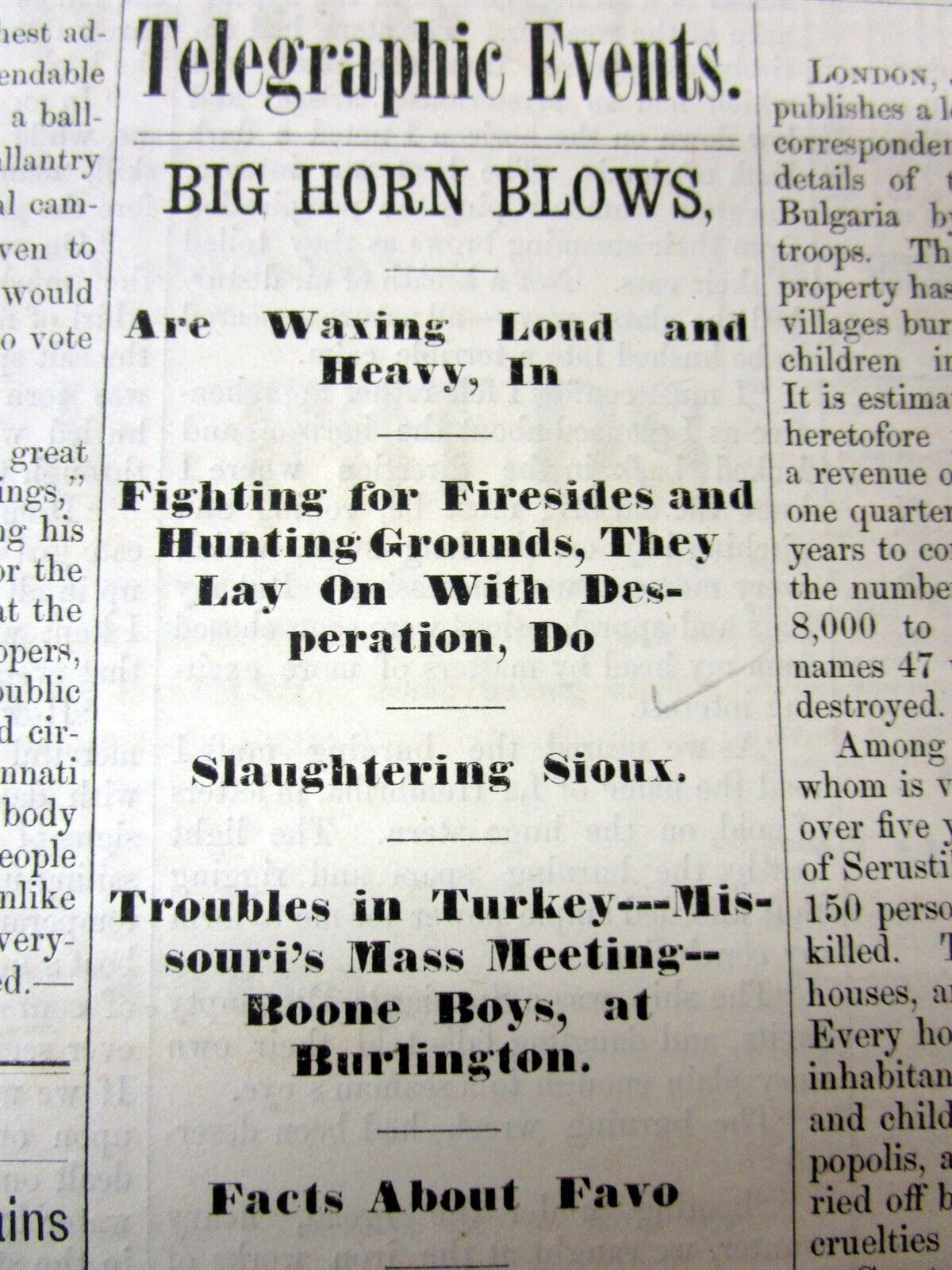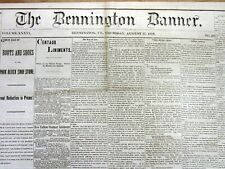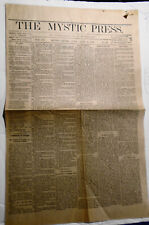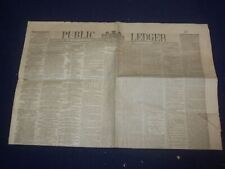When you click on links to various merchants on this site and make a purchase, this can result in this site earning a commission. Affiliate programs and affiliations include, but are not limited to, the eBay Partner Network.
1876 newspaper BATTLE of THE ROSEBUD Sioux Indian War GEN GEORGE CUSTER MASSACRE
1876 newspaper BATTLE of THE ROSEBUD Sioux Indian War - Precurser to the GENERAL GEORGE CUSTER MASSACRE at Little Big Horn- inv # 1J-420
Please visit our store for THOUSANDS MORE HISTORICAL NEWSPAPERS for SALE or at sale
SEE PHOTO(s) - COMPLETE ORIGINALNEWSPAPER,theMadison Patriot(WI) datedJune 24, 1876.This original newspaper contains prominent \"stacked\" front page headlines and 2/3 column of text describing the BATTLE OF THE ROSEBUD, the precurser battle to the BATTLE OF LITTLE BIG HORN, also known as the CUSTER MASSACRE at Little Big Horn.
The Battle of the Little Bighorn and commonly referred to as Custer\'s Last Stand, was an armed engagement between combined forces of the Lakota Sioux, Northern Cheyenne, and Arapaho tribes and the 7th Cavalry Regiment of the United States Army. The battle, which resulted in the defeat of U.S. forces, was the most significant action of the Great Sioux War of 1876. It took place on June 25–26, 1876, along the Little Bighorn River in the Crow Indian Reservation in southeastern Montana Territory.
The Battle of the Rosebud (also known as the Battle of Rosebud Creek) took place on June 17, 1876, in the Montana Territory between the United States Army and its Crow and Shoshoni allies against a force consisting mostly of Lakota Sioux and Northern Cheyenne Indians during the Great Sioux War of 1876. The Cheyenne called it the Battle Where the Girl Saved Her Brother because of an incident during the fight involving Buffalo Calf Road Woman. General George Crook\'s offensive was stymied by the Indians, led by Crazy Horse, and he awaited reinforcements before resuming the campaign in August.
On June 17, 1876, Crook\'s column marched northward along the south fork of Rosebud Creek. The holiday atmosphere that prevailed since the arrival of the Indian scouts on June 15 was suddenly absent. The soldiers, particularly the mule-riding infantry, were fatigued from the previous day\'s 35 miles (56 km) march and the early morning reveille at 3:00 am. At 8 am, Crook stopped to rest his men and animals. Although deep in hostile territory, Crook made no special dispositions for defense. His troops halted in their marching order. The Crow and Shoshoni scouts remained alert while the soldiers rested. Soldiers in camp began to hear gunfire coming from the bluffs to the north, where the Crow and Shoshoni were positioned, but initially thought it was the Crow shooting buffalo. As the intensity of fire increased, two Crows rushed into the army\'s resting place shouting, \"Lakota, Lakota!\" By 8:30 am, the Sioux and Cheyenne had hotly engaged Crook\'s Indian allies on the high ground north of the main body. Heavily outnumbered, the Crow and Shoshoni fell back toward the camp, but their fighting withdrawal gave Crook time to deploy his forces.
The battle which ensued would last for six hours and consist of disconnected actions and charges and counter-charges by Crook and Crazy Horse, the two forces spread out over a fluid front three miles wide. The Lakota and Cheyenne were divided into several groups as were the soldiers as the battle progressed. The soldiers could fend off assaults by the Indians and force them to retreat but could not catch and destroy them.
Crook initially directed his forces to seize the high ground north and south of the Rosebud Creek. He ordered Captain Van Vliet with two troops of the 3rd Cavalry to occupy the high bluffs south of the Creek to guard against an Indian attack from the direction. In the north, the commands of Major Chambers with two companies of the 4th Infantry and three companies of the 9th Infantry and Captain Noyes with three troops of the 2nd Cavalry, formed a dismounted skirmish line and advanced toward the Lakota. Their progress was slow due to flanking fire from Indians occupying the high ground to the northeast.
To accelerate the advance, Crook ordered Captain Anson Mills, commanding six troops of the 3rd Cavalry, to charge the Lakota. Mills\' mounted charge unnerved the Indians and they withdrew along the ridge line. Mills quickly re-formed three troops and led another charge, driving the Indians northwest again to the next hill. Preparing to drive the Indians from there, Mills received orders from Crook to cease the advance and assume a defensive posture. Chambers and Noyes led their forces forward in support and within minutes joined Mills on top of the ridge. The bulk of Crook\'s command, joined by the packers and miners, occupied a hill they called Crook\'s Hill. Establishing his headquarters there at approximately 9:30 am, Crook considered his next move.
During Mills\' advance the event occurred that would name the battle for the Cheyenne. A Cheyenne warrior, Comes in Sight, had his horse shot. While fleeing on foot from Mills\' advancing soldiers, his sister Buffalo Calf Road Woman (Mutsimiuna) rode to his rescue. Comes in Sight jumped onto her horse and the two successfully escaped. Mills was impressed with the swarming Indians at his front. \"They were the best cavalry soldiers on earth. In charging up toward us they exposed little of their person, hanging on with one arm around the neck and one leg over the horse, firing and lancing from underneath the horses\' necks, so that there was no part of the Indian at which we could aim.\"
Crook\'s initial charges secured key terrain but did little damage to the Indians. Assaults scattered the Indians but they did not quit the field. After falling back, the Lakota and Cheyenne kept firing from a distance and attacked several times in small parties. When counterattacked by the soldiers, the warriors sped away on their swift horses. Crook realized his charges were ineffective.
Crook believed incorrectly that the unusual tenacity of the Lakota and Cheyenne was based on defense of their families in a nearby village. He ordered Captains Mills and Noyes to withdraw their cavalry from the high ground on Crook\'s Hill and swing eastward to follow the Rosebud north to find the suspected village. He recalled Van Vliet\'s battalion from the south side of the Rosebud to reinforce him on Crook\'s Hill. While Mills and Noyes made their way up the Rosebud, searching for a village that did not exist, the situation of Lt. Colonel William B. Royall, Crook\'s second in command, had worsened. Royall had pursued the Indians attacking Crook\'s camp with six companies of cavalry. Royall advanced rapidly along the ridge line to the northwest to a point about one mile away from Crook and separated by the valley of Kolmarr Creek. The Lakota and Cheyenne shifted their main effort away from Crook and concentrated their attacks on Royall, and he was in danger of being cut off from Crook. Seeing this danger, Crook sent orders to Royall to withdraw to Crook\'s Hill. Royall sent only one company to join Crook, claiming later his forces had been too hotly engaged to withdraw.
Royall\'s situation continued to worsen, and he tried to withdraw his entire command across Kollmar Creek, but the Indians\' fire was too heavy. Next, he began to withdraw southeast along the ridge line. A large group of Sioux and Cheyenne broke off from the fight against Crook\'s main forces and charged boldly down the valley of Kollmar Creek, advancing all the way to the Rosebud. When Captain Guy V. Henry was wounded, his soldiers began to panic, but the Crow and Shoshoni arrived and drove the Lakota and Cheyenne back. Crook also sent two infantry companies to occupy a nearby hill to aid Royall with long-range rifle fire, which kept the Lakota and Cheyenne at a distance. The Lakota and Cheyenne did not attempt any serious attacks on the infantry, respecting the longer range of their rifles as compared to the carbines the cavalry carried. The Crow, Shoshoni, and the two infantry companies probably saved Royall\'s command from destruction.
At approximately 11:30, Royall continued his withdrawal to the southeast and assumed a new defensive position. He was under attack on three sides. From his headquarters, Crook realized that Royall needed help that only Mills\' force, which was descending Rosebud Creek two or three miles away, could provide. Crook sent orders to Mills redirecting him to turn west and attack the rear of the Indians pressing Royall.
At approximately 12:30, Royall began another withdrawal into the Kollmar ravine. His cavalry remounted and prepared to ride through gunfire to reach the relative safety of Crook\'s main position. As the US cavalry began their dash, the Crow and Shoshoni scouts counter-charged the pursuing Lakota and Cheyenne and relieved much of the pressure on Royall\'s men. The two companies of infantry provided covering fire from the northeast side of the ravine. Royall\'s command suffered most of the U.S. casualties during the battle.
Mills arrived too late on the Lakota and Cheyenne flank to assist Royall\'s withdrawal, but his unexpected appearance caused the Lakota and Cheyenne to break contact and retire from the battlefield. The cavalry pursued the Indians, but soon gave up the chase. The battle of the Rosebud was over about 2:30 pm.
Very good condition. This listing includes thecomplete entire original newspaper, NOT just a clipping or a page of it. STEPHEN A. GOLDMAN HISTORICAL NEWSPAPERS stands behind all of the items that we sell with a no questions asked, money back guarantee. Every item we sell is an original newspaper printed on the date indicated at the beginning of its description. U.S. buyers paypriority mail postage which includes waterproof plastic and a heavy cardboard flat to protect the purchased itemfrom damage in the mail. Uponrequest by the buyer, we can ship by USPS Media Mail to reduce postage cost; however, please be aware that USPS Media Mailcanbe very slow in its time of transit to the buyer.International postage is quoted when we are informed as to where the package is to be sent. We do combine postage (to reduce postage costs) for multiple purchases sent in the same package. We list thousands of rare newspapers with dates from 1570 through 2004 on each week. This is truly SIX CENTURIES OF HISTORY that YOU CAN OWN!
Stephen A. Goldman Historical Newspapers has been in the business of buying and selling historical newspapers for over 50 years. Dr. Goldman is a consultant to the Freedom Forum Newseum and a member of the American Antiquarian Society. You can buy with confidence from us, knowing that we stand behind all of our historical items with a 100% money back guarantee. Let our 50+ years of experience work for YOU ! We have hundreds of thousands of historical newspapers (and their very early precursors) for sale.
Stephen A. Goldman Historical Newspapershas been in the business of buying and selling historical newspapers for over 50 years. We are located in the charming Maryland Eastern Shore town of OXFORD, Maryland.
Dr. Goldman is a consultant to the Freedom Forum Newseum and a member of the American Antiquarian Society. You can buy with confidence from us, knowing that we stand behind all of our historical items with a 100% money back guarantee. Let our 50+ years of experience work for YOU ! We have hundreds of thousands of historical newspapers (and their very early precursors) for sale.
We invite customer requestsforhistorical newspapers that are not yetlocated in our extensive listing ofitems. With an inventory of nearlya million historical newspapers (and their early precursors) we arelikely have just the one YOU are searching for.
WE ARE ALSO ACTIVE BUYERS OF HISTORICAL NEWSPAPERS, including large and small personal collections, bound volumes, significant individual issues, or deaccessions from libraries and historical societies. IF YOU WANT TO SELL, WE WANT TO BUY !!!
Powered by SixBit\'s eCommerce Solution







